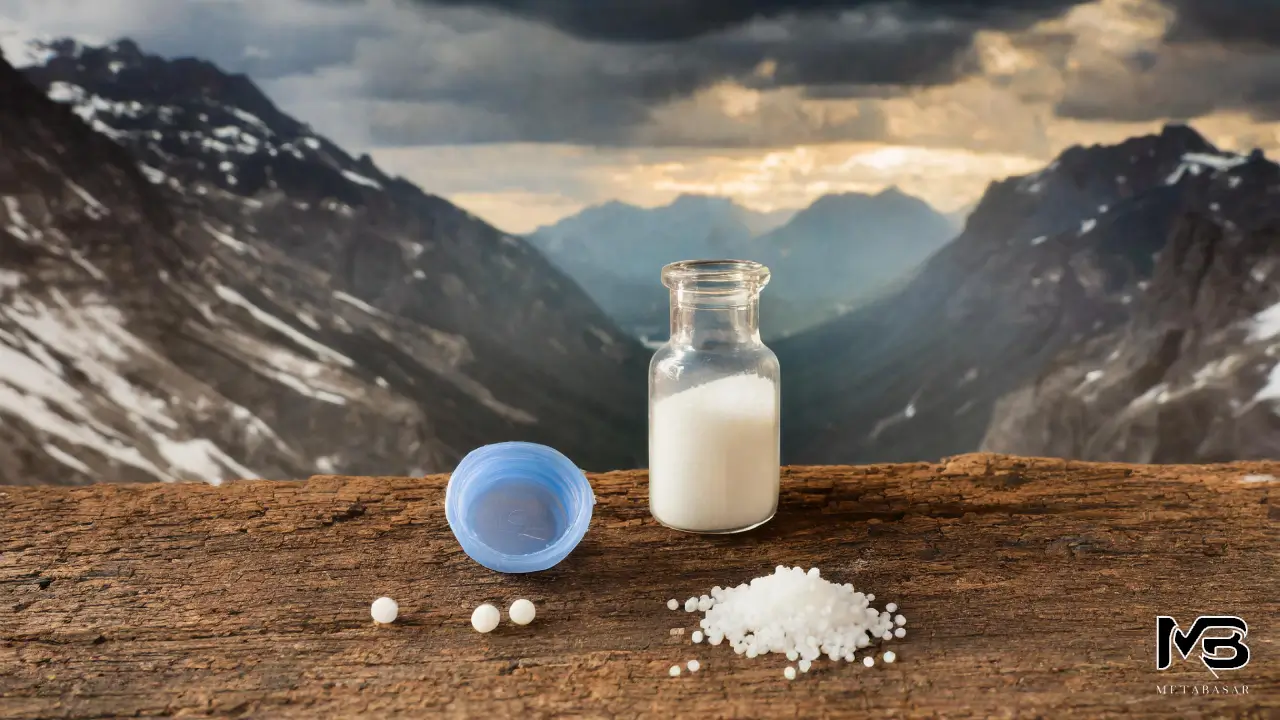Understanding Urea 46% for Potassium Cyanate

In the world of fertilizers, urea 46% takes center stage as one of the most important nitrogenous compounds. With its highest nitrogen content among all solid nitrogenous fertilizers, urea 46% plays a vital role in both agricultural and industrial applications. It serves as a feedstock for the production of many chemical compounds and is commonly used as a fertilizer. Additionally, urea 46% plays a crucial role in the production of potassium cyanate, a chemical compound used in various industries. In this blog, we will explore the characteristics of urea 46%, its role in potassium cyanate production, the different methods of urea production, its applications, advantages, and potential drawbacks. We will also discuss the safe storage and handling of urea 46%, ensuring proper precautions are taken when working with this important chemical compound.
Table of Content
Exploring Urea 46%
Urea 46% is a white crystalline solid that is commonly used as a fertilizer due to its highest nitrogen content among all solid nitrogenous fertilizers. It serves as an important industrial feedstock for the manufacture of many chemical compounds. The production of urea involves the combination of ammonia and carbon dioxide, making it a relatively cheap source of nitrogen fertilizer. This high nitrogen content fertilizer finds use in a variety of applications, from plant growth enhancement to industrial feedstock.
Characteristics of Urea 46%
Urea 46% stands out for its high nitrogen content, making it an efficient nitrogen fertilizer. Its solid form allows for easy handling and application. Urea fertilizer, in its granular form, dissolves quickly, providing plants with a readily available source of nitrogen. This characteristic makes it ideal for use in both farming and industrial applications. Its versatility extends beyond fertilizers, as urea solution is also used in hair conditioners, facial cleansers, bath oils, and cold compresses. Solid urea, on the other hand, is utilized in the production of adhesives, resins, plywood, and melamine, among other industrial products.
Role in Potassium Cyanate Production
Urea’s Role in Potassium Cyanate Production
Urea 46% plays a crucial role in the production of potassium cyanate, an important chemical compound used in various industries. Here are some key points to highlight its significance:
- Urea acts as an important raw material in the production of potassium cyanate.
- Potassium cyanate is synthesized through a chemical reaction between urea and rock salt.
- The production of potassium cyanate using urea has paved the way for the manufacture of many chemical compounds.
- Urea’s chemical composition, which includes the highest nitrogen content, is essential for the production of potassium cyanate.
- Potassium cyanate, derived from urea, provides nitrogen products for various applications in different industries.
Production Methods for Urea 46%
Urea production is a complex process that involves the combination of nitrogen and carbon dioxide. It is one of the world’s most produced nitrogenous fertilizers. Let’s take a closer look at two production methods commonly used in urea production.
Bosch-Meiser Process Overview
The Bosch-Meiser Process Overview
The Bosch-Meiser process is a widely employed production method for urea. Here are some key points to understand this process:
- The production of urea using the Bosch-Meiser process starts with the formation of ammonium carbamate, which is then converted into urea.
- This process requires ammonia and carbon dioxide as raw materials, which are reacted under high pressure and temperature to form urea with high nitrogen content.
- The Bosch-Meiser process is important in urea production for both industrial feedstock applications and farming, where high nitrogen content fertilizers are necessary.
Haber-Bosch Method Examination
The Haber-Bosch Method Examination
Another widely used method for urea production is the Haber-Bosch method. Here are some key points about this method:
- The Haber-Bosch method involves the production of ammonia and carbon dioxide, which are combined to form urea fertilizer.
- Natural gas and hydrogen serve as the primary raw materials in this process, which can be completed in the shortest possible time.
- The use of the Haber-Bosch method is crucial for urea production in various industrial applications and farming practices, where high nitrogen content fertilizers are required.
Urea 46% Applications
Urea 46% finds applications in both industrial and agricultural fields, making it a versatile nitrogenous compound.
Agricultural Uses
Agricultural Uses of Urea 46%
In farming, urea fertilizer is commonly used to enhance plant growth. Here’s why it is favored:
- Urea fertilizer, with its high nitrogen content, supports plant growth by providing an efficient source of nitrogen for crops.
- Its high nitrogen content allows for efficient use of fertilizers, ensuring optimal plant growth and yield.
- Urea fertilizer is used in farming applications to improve soil nitrogen content, resulting in healthy plant growth.
- The high nitrogen content of urea fertilizer makes it a preferred choice for agricultural applications, especially for nitrogen-hungry crops.
Industrial Uses
Industrial Uses of Urea 46%
Aside from its applications in agriculture, urea 46% serves as an industrial feedstock for the production of various chemical compounds, including melamine and resins. Here’s a closer look:
- Urea fertilizer is utilized as an industrial feedstock, playing a crucial role in the manufacture of many important chemical compounds.
- Its high nitrogen content contributes to the production of melamine, resins, and other industrial products.
- Urea’s versatility extends to applications such as the production of marine plywood, where it acts as an additive.
- Many chemical compounds benefit from urea’s high nitrogen content, making it an essential raw material in the chemical industry.
Advantages of Using Urea 46%
The use of urea 46% comes with several advantages, making it a preferred choice for many applications.
High Nitrogen Content
High Nitrogen Content as an Advantage
One of the key advantages of urea 46% is its high nitrogen content, which surpasses that of all solid nitrogenous fertilizers. Here’s why it matters:
- As the fertilizer with the highest nitrogen content, urea 46% is highly efficient, ensuring plants receive a sufficient supply of nitrogen for growth.
- Its high nitrogen content also makes urea fertilizer a cost-effective option, as less fertilizer is required for the same amount of nitrogen.
Environmental Benefits
Environmental Benefits of Urea 46%
Apart from its role in plant growth, there are environmental benefits associated with urea 46%. Here’s why it is considered environmentally friendly:
- Urea, as a source of nitrogen, is relatively cheap, leading to widespread use and reduced contamination from other nitrogen compounds.
- Compared to other fertilizers, urea has lower contamination levels, particularly of biuret, making it a safer choice for the environment.
Potential Disadvantages of Urea 46%
Despite its many advantages, urea 46% comes with some potential drawbacks that need to be considered.
Volatility Concerns
Volatility Concerns
One of the main concerns with urea 46% is its volatility, which can lead to nitrogen loss and ammonia emissions. Here are some points to understand:
- Urea, due to its high nitrogen content, is prone to volatilization, which can result in nitrogen loss from the soil.
- Volatility occurs when urea granules quickly break down, releasing ammonia into the atmosphere, reducing fertilizer effectiveness.
Acidity Issues
Acidity Issues
Another potential drawback of urea 46% is its contribution to soil acidity. Here’s what you need to know:
- Urea’s high nitrogen content can cause soil acidity, which can have adverse effects on plant growth and nutrient availability.
- Accurate fertilization practices, including monitoring pH levels, are necessary to prevent acidity issues when using urea 46%.
Safe Storage and Handling of Urea 46%
To ensure the safe use of urea 46%, proper storage and handling procedures must be followed.
Best Practices for Storage
Best Practices for Storage
Proper storage of urea 46% is crucial to maintain its quality. Here are some best practices to keep in mind:
- Store urea nitrogen fertilizer away from moisture or sources of contamination, as it is hygroscopic and can absorb moisture from the environment.
- Use appropriate packaging, such as moisture-resistant bags, to prevent moisture absorption.
- Store urea prills in a designated area, separate from other chemicals, to avoid cross-contamination.
- Take into account the diameter of urea prills when handling, as smaller prills are more susceptible to volatility.
- Regularly inspect storage areas to ensure no leaks or damage that could compromise urea nitrogen fertilizer quality.
Is Urea 46% safe for human contact?
Safety of Urea 46% for Human Contact
When properly handled, urea 46% is safe for human contact. Here are some important points to consider:
- Adhere to safety protocols and wear appropriate personal protective equipment when handling urea 46% to minimize the risk of exposure.
- Urea 46%, if stored and handled according to specifications, does not pose a direct risk to human health.
- However, accidental ingestion, inhalation of dust or fumes, or physical contact with the chemical should be avoided, and medical attention sought immediately in case of exposure.
Frequently Asked Questions
What is Urea 46% and how is it used in the production of potassium cyanate?
Q: What is Urea 46% and how is it used in the production of potassium cyanate?
Urea 46% is a white crystalline solid fertilizer with the highest nitrogen content. In the production of potassium cyanate, urea 46% is heated at high temperatures, breaking down into cyanuric acid. Further treatment of cyanuric acid with potassium hydroxide leads to the formation of potassium cyanate. Urea 46% serves as a crucial precursor in the synthesis of potassium cyanate, enabling its use in various applications in the chemical industry.
What are some common applications for potassium cyanate?
Q: What are some common applications for potassium cyanate?
Potassium cyanate finds applications in several industries, including:
- The production of urea, where potassium cyanate is a crucial chemical compound.
- Its use as a fertilizer, herbicide, and insecticide.
- The manufacturing of synthetic fibers and pharmaceuticals.
- It’s important to note that proper safety precautions should be taken when handling potassium cyanate due to its toxic nature.
Are there any safety precautions that should be taken when working with Urea 46% and/or potassium cyanate?
When working with Urea 46% and/or potassium cyanate, it’s crucial to take safety precautions. Wear protective gear like gloves and goggles, work in a well-ventilated area, and avoid inhaling dust or fumes. In case of accidental exposure, seek immediate medical attention.
Conclusion
In conclusion, Urea 46% is a versatile compound with various applications in agriculture and industry. Its high nitrogen content makes it an effective fertilizer, promoting plant growth and increasing crop yield. Additionally, it plays a crucial role in the production of potassium cyanate, a key ingredient in the manufacturing of several industrial products.
Despite its advantages, there are a few considerations to keep in mind when using Urea 46%. Its volatility and acidity levels can pose challenges in storage and handling, requiring proper precautions to ensure safety. It is important to follow best practices for storage and minimize human contact with the compound.
Overall, Urea 46% offers significant benefits and opportunities, but it is essential to handle it with care and adhere to safety guidelines. If you have any more questions about Urea 46% or its applications, refer to our frequently asked questions section for further information.


